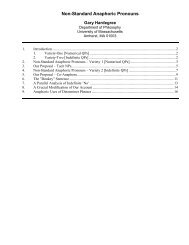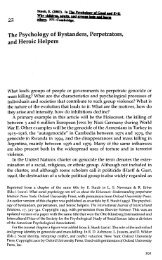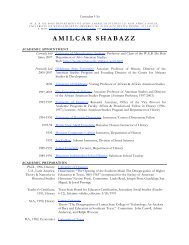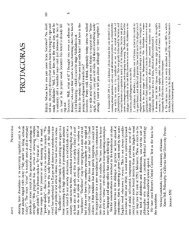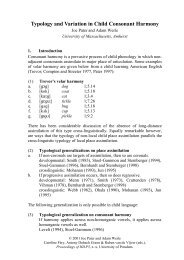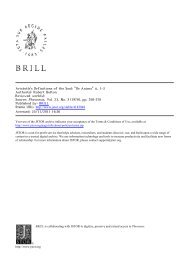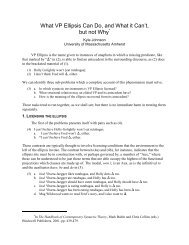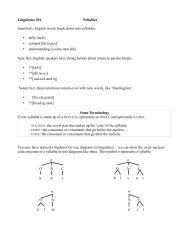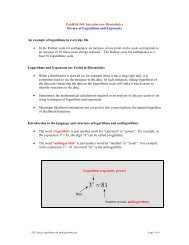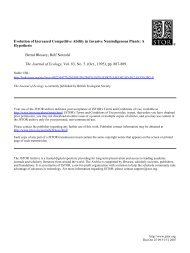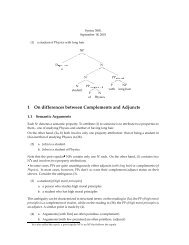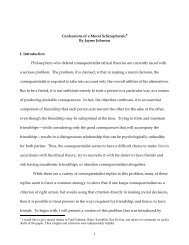HISTORY OF PHILOSOPHY Outlines of Scepticism
HISTORY OF PHILOSOPHY Outlines of Scepticism
HISTORY OF PHILOSOPHY Outlines of Scepticism
You also want an ePaper? Increase the reach of your titles
YUMPU automatically turns print PDFs into web optimized ePapers that Google loves.
[25<br />
<strong>Outlines</strong> <strong>of</strong> <strong>Scepticism</strong> Book I<br />
xii What is the aim <strong>of</strong> <strong>Scepticism</strong>?<br />
]44S It will be apposite to consider next the aim <strong>of</strong> the Sceptical<br />
persuasion. Now an aim is that for the sake <strong>of</strong> which everything is<br />
done or considered, while it is not itself done or considered for the<br />
sake <strong>of</strong> anything else.<br />
48 Up to<br />
47 Or: an aim is the final object <strong>of</strong>desire.<br />
now we say the aim <strong>of</strong> the Sceptic is tranquillity in matters <strong>of</strong> opinion<br />
and moderation <strong>of</strong> feeling in matters forced upon us. [261 For<br />
Sceprics began to do philosophy in order to decide among appear<br />
ances and to apprehend which are true and which false, so as to<br />
49 but they came upon equipollent dispute, and<br />
become tranquil;<br />
being unable to decide this they suspended judgement. And when<br />
they suspended judgement, tranquillity in matters <strong>of</strong> opinion fol<br />
lowed fortuitously.<br />
[27]° For those who hold the opinion that things are good or bad<br />
by nature are perpetually troubled. When they lack what they believe<br />
to be good, they take themselves to be persecuted by natural evils and<br />
they pursue what (so they think) is good. And when they have<br />
acquired these things, they experience more troubles; for they are<br />
elated beyond reason and measure, and in fear <strong>of</strong> change they do<br />
anything so as not to lose what they believe to be good. [aS] But those<br />
who make no determination about what is good and bad by nature<br />
neither avoid nor pursue anything with intensity; and hence they are<br />
tranquil.<br />
5’ They<br />
A story told <strong>of</strong> the painter Apelles applies to the Sceptics.<br />
say that he was painting a horse and wanted to represent in his picture<br />
the lather on the horse’s mouth; but he was so unsuccessful that he<br />
gave up, took the sponge on which he had been wiping <strong>of</strong>f the<br />
colours from his brush, and flung it at the picture. And when it hit the<br />
With z—o cf. in 235—8, M xx 110—67; Timon, frag. 8i Lloyd-Jones and<br />
Parsons (see BURNYEAT [1980bj); Diogenes Laerrius IX 107—8. See esp. STRIKER<br />
[199oa]; ANNAS [1993a], chh. i, ri.<br />
A standard definition: e.g. Cicero,fin t xii.i.z (Epicureans); Anus ap. Stobaeus,<br />
ccl II 77.16—17 (Stoics), 131.2—4 (Peripaterics).<br />
48 Again, a standard definition; see e.g. Anus ap. Stobaeus, eel II 76.21—4. (Stoics),<br />
131.4. (Periparetics); Alexander, an mant 15o.zo—i, x6zj....<br />
See i iz.<br />
° Cf. iii 237—8; M xi 112—18, 145—6 (and below, i<br />
On this paragraph see ANNAS and BARNES [19851, pp. 167—171.<br />
picture, it produced a representation <strong>of</strong> the horse’s lather. [29] Now<br />
the Sceptics were hoping to acquire tranquillity by deciding the<br />
anomalies in what appears and is thought <strong>of</strong>, and being unable to do<br />
this they suspended judgement. But when they suspended judge<br />
ment, tranquillity followed as it were fortuitously, as a shadow<br />
52<br />
follows a body.<br />
We do nor, however, take Sceprics to be undisturbed in every<br />
way<br />
53 —<br />
we<br />
say that they are disturbed by things which are forced<br />
upon them; for we agree that at times they shiver and are thirsty and<br />
have other feelings <strong>of</strong> this kind.<br />
54 [30] But in these cases ordinary<br />
people are afflicted by two sets <strong>of</strong> circumstances: by the feelings<br />
themselves, and no less by believing that these circumstances are bad<br />
by nature. Sceptics, who shed the additional opinion that each <strong>of</strong><br />
these things is bad in its nature, come <strong>of</strong>f more moderately even in<br />
these cases.<br />
This, then, is why we say that the aim <strong>of</strong> Sceptics is tranquillity in<br />
matters <strong>of</strong> opinion and moderation <strong>of</strong> feeling in matters forced upon<br />
us. (Some eminent Sceptics have added as a further aim suspension <strong>of</strong><br />
55)<br />
judgement in investigations.<br />
xiii The general modes <strong>of</strong> suspension <strong>of</strong>judgement<br />
[33] Since we have been saying that tranquillity follows suspension <strong>of</strong><br />
judgement about everything, it will be apposite here to say how<br />
suspension <strong>of</strong> judgement comes about for us.<br />
It comes about —<br />
to<br />
put it rather generally —<br />
through<br />
the opposition<br />
<strong>of</strong> things. We oppose what appears to what appears, or what is<br />
thought <strong>of</strong> to what is thought <strong>of</strong>, or crosswise.<br />
56 [32] For example, we<br />
oppose what appears to what appears when we say: ‘The same tower<br />
appears round from a distance and square from nearby’.<br />
57 We oppose<br />
52 See Diogenes Laertius LX 107 (referring the image to Timon and Aenesidemus);<br />
below, 1205.<br />
Cf III 235—6; M xx ii—6o.<br />
See I 13.<br />
So Timon and Aenesidemus, according to Diogenes Laertius Ix io.<br />
See 1 8—9.<br />
A standard example: e.g. 1118; lIss; M vii zo8, 414; Lucretius IV 353—63; see<br />
ANNAS and BARNES [1985], pp. 104—6.



